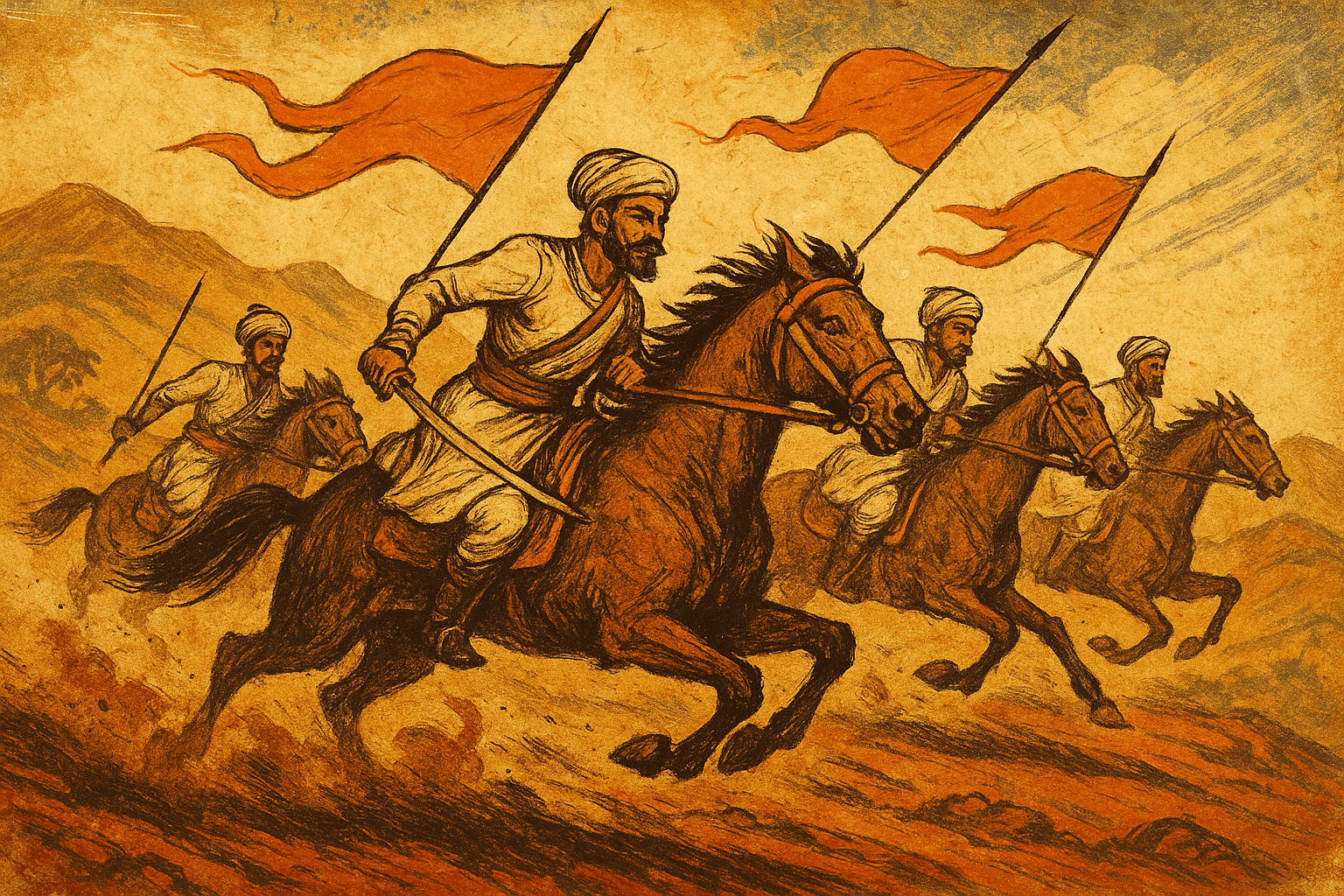Shivaji Maharaj: The Father of a Rebellion
The story of the Maratha Empire begins with one man: Chhatrapati Shivaji Maharaj. Born in 1630, Shivaji was the son of a Maratha nobleman serving the Sultanate of Bijapur. But Shivaji was not content to be a mere vassal. Fueled by a vision of Hindavi Swarajya (self-rule of Hindu people), he began a daring campaign of resistance from his base in modern-day Maharashtra.
The terrain was his greatest ally. The steep hills, narrow valleys, and a network of formidable forts provided the perfect theater for his revolutionary military doctrine: Ganimi Kava, or guerrilla warfare. The Mughals and other Sultanates fielded massive, slow-moving armies accustomed to pitched battles on open plains. Shivaji refused to play their game. His light, swift cavalry would strike from unexpected quarters, raid supply lines, and vanish back into the hills before the enemy could mount an effective response. He was derisively nicknamed the “Mountain Rat” by his enemies, a title that inadvertently acknowledged his mastery of the landscape.
Two events perfectly encapsulate his genius:
- The Confrontation with Afzal Khan (1659): Sent by the Bijapur Sultanate to crush the rebellion, the giant general Afzal Khan boasted he would capture Shivaji without dismounting his horse. Shivaji, feigning fear, agreed to a private meeting. In a calculated act of audacious defense, he wore armor under his clothes and concealed a deadly wagh nakh (tiger claw) in his hand. When Afzal Khan tried to stab him during an embrace, Shivaji disemboweled the general. The pre-planned signal was given, and his hidden troops descended upon the leaderless and bewildered Bijapuri army, securing a legendary victory.
- The Sack of Surat (1664): In a move of incredible boldness, Shivaji led a lightning raid on Surat, the wealthiest Mughal port city. He wasn’t there to conquer it, but to deliver a devastating blow to Mughal prestige and finance. The raid sent shockwaves through the empire and announced that the Marathas were no mere regional nuisance but a serious threat to Mughal authority.
Shivaji was more than just a brilliant tactician. He was a visionary administrator who built a disciplined army, established a powerful navy to protect the coastline, and implemented a just revenue system that supported the peasantry. His coronation in 1674 as Chhatrapati (Sovereign Monarch) formalized the establishment of an independent Maratha state, a beacon of defiance in the heart of Mughal territory.
From Kingdom to Confederacy: The Peshwa Era
After Shivaji’s death in 1680, the Marathas faced a brutal 27-year war against a determined Emperor Aurangzeb. Though the Mughals captured and executed Shivaji’s son, Sambhaji, they could not extinguish the flame of Maratha resistance. The war bled the Mughal treasury dry and hardened an entire generation of Maratha warriors.
The 18th century saw a fundamental transformation in Maratha governance. Under Shivaji’s grandson, Chhatrapati Shahu, real political power shifted from the monarch to his chief minister, the Peshwa. The first of these powerful Peshwas, Balaji Vishwanath, cemented this arrangement, making the position hereditary. This created a unique political structure: a Maratha Confederacy.
The Peshwas, based in Pune, acted as the federal head, while powerful Maratha chiefs were granted semi-autonomous territories (fiefdoms) to govern and expand. This decentralized system allowed for rapid, multi-pronged expansion across the subcontinent. The most prominent families of this confederacy were:
- The Gaekwads of Baroda
- The Holkars of Indore
- The Scindias (or Shindes) of Gwalior
- The Bhonsles of Nagpur
United by a common cause but operating with considerable independence, these warlord families pushed the boundaries of the empire at an astonishing pace.
“From Attock to Cuttack”: The Zenith of an Empire
By the mid-18th century, the Maratha Empire had reached its zenith. The phrase “Attock to Cuttack” was used to describe their vast influence, which stretched from the Indus River in modern-day Pakistan to Odisha on the Bay of Bengal. They had effectively replaced the Mughals as the dominant power in India. Mughal emperors in Delhi became their pensioners and puppets, ruling only in name.
Maratha armies marched with impunity across the plains of northern India, collecting their signature taxes—chauth (one-fourth of the revenue) and sardeshmukhi (an additional 10%)—from provinces that were still nominally Mughal. They were the arbiters of power, the kingmakers, and the masters of a vast, sprawling, and complex political system.
Decline and Lasting Legacy
The very ambition that fueled their rise also contained the seeds of their decline. The constant north-bound expansion brought them into conflict with the Afghan ruler Ahmad Shah Abdali. The resulting Third Battle of Panipat in 1761 was a catastrophe for the Marathas. Though not immediately fatal to the empire, the battle shattered the myth of their invincibility and killed off an entire generation of its top leadership.
The confederacy, which had been a strength, began to fray as internal rivalries and jealousies intensified. It was this disunity that a new foreign power, the British East India Company, expertly exploited. Through a series of three Anglo-Maratha Wars fought between 1775 and 1818, the British, with their superior military discipline and cunning diplomacy, dismantled the confederacy piece by piece. By 1818, the last Peshwa was defeated, and the Maratha sun had finally set.
Despite their fall, the legacy of the Marathas is profound. They accelerated the collapse of the Mughal Empire, creating the power vacuum that the British would eventually fill. More importantly, they championed a powerful political and cultural identity that resonated across the region, proving that a determined, well-led force from humble beginnings could rise to command a subcontinent. The dramatic saga of the Maratha Empire remains one of the most compelling chapters in the long and rich history of India.
